Study on Performance of a Modified Two-Stage Piston Expander Based on Spray Heat Transfer
Abstract
:1. Introduction
2. Working Principle and Structural Characteristics
3. Mathematic Model
- (1)
- The compressed air is ideal, and the gas flows into or out of the cylinder in quasi-steady flow;
- (2)
- The M-TSPE has no gas leakage during the working process;
- (3)
- Ignoring the mass transfer between water mist and air;
- (4)
- All mechanical components are rigid bodies;
- (5)
- The pipeline volume connecting the I-stage cylinder and the II-stage cylinder is not considered;
- (6)
- The throttling effect of water mist filter on air is not considered;
- (7)
- The volume of water only accounts for 0.09–2.3% of the cylinder volume, so the influence of water mist volume on cylinder volume can be ignored.
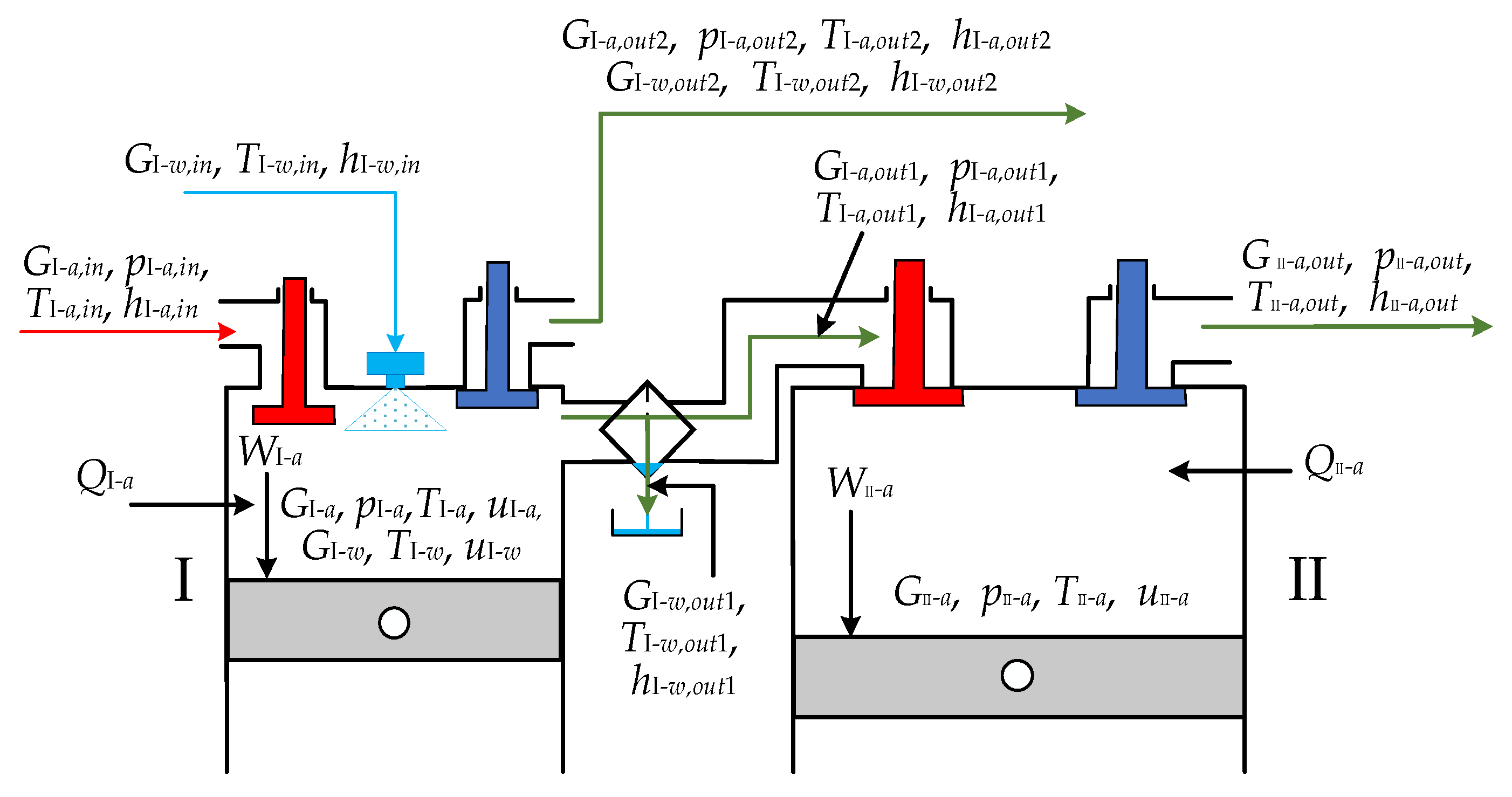
3.1. Air Expansion Model
3.2. Heat Exchange Model of Water Mist
3.3. Piston Motion Model
4. Simulation Calculation and Result Analysis
4.1. Simulation Parameter Setting
4.2. Performance Analysis
4.3. Influence of Air/Water Mass Ratio and Water Mist Particle Size on Performance of the M-TSPE
5. Conclusions
- Compared with the TSPE without spray, the output performance of the M-TSPE without spray is better under reasonable setting of the intake/exhaust valve timing. The output power and efficiency of the M-TSPE without spray increased by 57.58% and 13.28%, respectively.
- When the crankshaft velocity is in the stable stage, the crankshaft velocity amplitude of the M-TSPE with spray is smaller than that of the M-TSPE without spray, indicating that the output velocity of the M-TSPE with spray is more stable. The crankshaft velocity of the M-TSPE with spray increased by 13.93%.
- Through the comparative analysis of the p-V diagram, output torque, and in-cylinder air temperature under the single cycle of the M-TSPE, the reasons for the improved output performance of the M-TSPE with spray are disclosed.
- When the load torque is 150 N·m, the output power of the M-TSPE with spray is 16.08 kW, which is 13.08% higher than that of the M-TSPE without spray, the output efficiency of the M-TSPE with spray is lower than that of the M-TSPE without spray.
- Improving the quality of the water mist and reducing the water mist particle size during a cycle can improve the output performance of the expander.
Author Contributions
Funding
Institutional Review Board Statement
Informed Consent Statement
Data Availability Statement
Conflicts of Interest
Abbreviations
| Symbols Concepts, Units | |
| A | the heat transfer area, m2 |
| BDC | bottom dead center |
| c | coefficient |
| Cp | specific heat at constant pressure, kJ/(kg·k) |
| CAES | compressed air energy storage system |
| Cv | specific heat at constant volume, kJ/(kg·k) |
| CD | drag coefficient |
| d | cylinder diameter, m |
| df | flow diameter, m |
| dv | valve diameter, m |
| Ek | kinetic energy |
| Ep | potential energy |
| F | force, N |
| G | mass flow rate, kg/s |
| g | acceleration, m/s2 |
| h | specific enthalpy, kJ/kg |
| J | flywheel moment of inertia, kg·m2 |
| k | specific heat ratio |
| L | length of connecting rod, m |
| l | lift, m |
| m | mass, kg |
| n | crankshaft velocity, r/min |
| Nu | Nusselt number |
| p | pressure, bar |
| P | power, kW |
| Pr | Prandtl number |
| Q | heat exchange, kJ |
| R | gas constant |
| Re | Reynolds number |
| r | crank radius, m |
| S | effective cross-sectional area, m2 |
| Sw | water droplets surface area, m2 |
| T | temperature, K |
| TD | damping torque, N·m |
| TL | load torque, N·m |
| TDC | top dead center |
| u | specific internal energy, kJ/kg |
| v | velocity, m/s |
| V | volume, m3 |
| W | work, J |
| Greek letters | |
| η | efficiency |
| θ | crankshaft angle |
| β | connecting rod angle |
| ρ | density, kg/m3 |
| ω | crankshaft angular velocity |
| γ | valve cone angle |
| Subscripts | |
| I | first stage expander |
| II | second stage expander |
| a | air |
| w | water |
| in | inlet |
| out | outlet |
| e | atmosphere |
| v | valve |
| dv | dynamic viscosity |
| ht | heat transfer |
| H | upstream |
| L | downstream |
| f | friction |
| cr | crankshaft |
| fc | flywheel and crankshaft |
| ph | piston head |
| 1 | a part of |
| 2 | the other part |
References
- Tanaka, N. World Energy Outlook 2010; International Energy Agency: Beijing, China, 2010. [Google Scholar]
- Reve. China’s total installed capacity of renewable energy power generation exceeds 1 billion kW. Electr. Saf. Technol. 2021, 23, 34. [Google Scholar]
- He, W.; Dooner, M.; King, M.; Li, D.; Guo, S.; Wang, J. Techno-economic analysis of bulk-scale compressed air energy storage in power system decarbonization. Appl. Energy 2021, 282, 116097. [Google Scholar] [CrossRef]
- Tong, Z.; Cheng, Z.; Tong, S. A review on the development of compressed air energy storage in China: Technical and economic challenges to commercialization. Renew. Sustain. Energy Rev. 2021, 135, 110178. [Google Scholar] [CrossRef]
- Nadeem, F.; Hussain, S.M.S.; Tiwari, P.K.; Goswami, A.K.; Ustun, T.S. Comparative review of energy storage systems, their roles, and impacts on future power systems. IEEE Access 2019, 7, 4555–4585. [Google Scholar] [CrossRef]
- Yu, Q.; Wang, Q.; Tan, X.; Fang, G.; Meng, J. A review of compressed-air energy storage. J. Renew. Sustain. Energy 2019, 11, 042702. [Google Scholar] [CrossRef]
- Qian, P.; Pu, C.; Liu, L.; Li, X.; Zhang, B.; Gu, Z.; Meng, D. Development of a new high-precision friction test platform and experimental study of friction characteristics for pneumatic cylinders. Meas. Sci. Technol. 2022, 33, 065001. [Google Scholar] [CrossRef]
- Qian, P.; Pu, C.; Liu, L.; Lv, P.; Ruiz Páez, L.M. A novel pneumatic actuator based on high-frequency longitudinal vibration friction reduction, Sensors and Actuators: A. Physical 2022, 344, 113731. [Google Scholar]
- Qian, P.; Pu, C.; He, D.; Lv, P.; Páez, L.M.R. A method to improve the motion trajectory tracking accuracy of pneumatic servo system—By exciting longitudinal resonance. J. Braz. Soc. Mech. Sci. Eng. 2022, 44, 376. [Google Scholar] [CrossRef]
- He, W.; Wang, J. Optimal selection of air expansion machine in Compressed Air Energy Storage: A review. Renew. Sustain. Energy Rev. 2018, 87, 77–95. [Google Scholar] [CrossRef]
- Zhang, X.; Xu, Y.; Zhou, X.; Zhang, Y.; Li, W.; Zuo, Z.; Guo, H.; Huang, Y.; Chen, H. A near-isothermal expander for isothermal compressed air energy storage system. Appl. Energy 2018, 225, 955–964. [Google Scholar] [CrossRef]
- Yu, Q.; LI, X.; LI, X.; Tian, L.; Tan, X.; Zhang, Y. Performance Analysis and Experimental Verification of Piston Expander. Chin. Hydraul. Pneum. 2022, 46, 34–43. [Google Scholar]
- Yu, Q.; Shi, Y.; Cai, M.; Yang, K.; Zhou, X. Design and Characteristic Analysis for Multi-valve Air Powered Vehicle. Chin. Hydraul. Pneum. 2017, 8, 1–7. [Google Scholar]
- Yu, Q.; Li, X.; Geng, Y.; Tan, X. Study on quasi-isothermal expansion process of compressed air based on spray heat transfer. Energy Rep. 2022, 8, 1995–2007. [Google Scholar] [CrossRef]
- Jia, G.; Nian, X.; Xu, W.; Shi, Y.; Cai, M. Water-Spray-Cooled Quasi-Isothermal Compression Method: Water-Spray Flow Improvement. Entropy 2021, 23, 724. [Google Scholar] [CrossRef]
- Srivatsa, A.; Li, P.Y. How moisture content affects the performance of a liquid piston air compressor/expander. J. Energy Storage 2018, 18, 121–132. [Google Scholar] [CrossRef]
- Patil, V.C.; Acharya, P.; Ro, P.I. Experimental investigation of water spray injection in liquid piston for near-isothermal compression. Appl. Energy 2020, 259, 114182. [Google Scholar] [CrossRef]
- Braasch, C.; Nieratschker, W.; Nadler, M.; Nett, D. Experimental and numerical investigation of heat transfer by water spray injection into pressurized gas atmospheres. Appl. Therm. Eng. 2022, 214, 118682. [Google Scholar] [CrossRef]
- Sivalingam, V.; Kumar, P.G.; Prabakaran, R.; Sun, J.; Velraj, R.; Kim, S.C. An automotive radiator with multi-walled carbon-based nanofluids: A study on heat transfer optimization using MCDM techniques. Case Stud. Therm. Eng. 2022, 29, 101724. [Google Scholar] [CrossRef]
- Ganeshkumar, P.; Kim S, C. Effect of shot peening on augmenting the thermo-fluid characteristic of a concentric tube water-to-air counter flow heat exchanger. Case Stud. Therm. Eng. 2021, 25, 100887. [Google Scholar]
- SustainX. Energy Storage and Generation Systems and Methods Using Coupled Cylinder Assemblies; SustainX, Inc.: Seabrook, NH, USA, 2013. [Google Scholar]
- Nachippan, N.M.; Parthasarathy, M.; Elumalai, P.; Backiyaraj, A.; Balasubramanian, D.; Hoang, A.T. Experimental assessment on characteristics of premixed charge compression ignition engine fueled with multi-walled carbon nanotube-included Tamanu methyl ester. Fuel 2022, 323, 124415. [Google Scholar] [CrossRef]
- Elumalai, P.V.; Dash, S.K.; Parthasarathy, M.; Dhineshbabu, N.R.; Balasubramanian, D.; Cao, D.N.; Truong, T.H.; Le, A.T.; Hoang, A.T. Combustion and emission behaviors of dual-fuel premixed charge compression ignition engine powered with n-pentanol and blend of diesel/ waste tire oil included nanoparticles. Fuel 2022, 324, 124603. [Google Scholar] [CrossRef]
- Liu, H.; Chen, Y.; Tao, G. Modeling and simulation of two-stage expansion air-powered engine. J. Zhejiang Univ. 2005, 5, 623–627. [Google Scholar]
- Liu, C.-M.; Huang, C.-L.; Sung, C.-K.; Huang, C.-Y. Performance analysis of a two-stage expansion air engine. Energy 2016, 115, 140–148. [Google Scholar] [CrossRef]
- Yu, Q.; Hao, X.; Xin, T. Performance analysis of an innovative kind of two-stage piston type expansion air engine. Adv. Mech. Eng. 2018, 10, 168781401877386. [Google Scholar] [CrossRef] [Green Version]
- Qiyue, X.; Yan, S.; Qihui, Y.; Maolin, C. Virtual prototype modeling and performance analysis of the air-powered engine. Proceedings of the Institution of Mechanical Engineers, Part, C. J. Mech. Eng. Sci. 2014, 228, 2642–2651. [Google Scholar] [CrossRef]
- Yu, Q.; Cai, M.; Shi, Y.; Xu, Q. Optimization study on a single-cylinder compressed air engine. Chin. J. Mech. Eng. 2015, 28, 8. [Google Scholar] [CrossRef]
- Odukomaiya, A.; Abu-Heiba, A.; Gluesenkamp, K.R.; Abdelaziz, O.; Jackson, R.K.; Daniel, C.; Graham, S.; Momen, A.M. Thermal analysis of near-isothermal compressed gas energy storage system. Appl. Energy 2016, 179, 948–960. [Google Scholar] [CrossRef]
- Chen, H.; Peng, Y.H.; Wang, Y.L.; Zhang, J. Thermodynamic analysis of an open type isothermal compressed air energy storage system based on hydraulic pump/turbine and spray cooling. Energy Convers. Manag. 2020, 204, 112293. [Google Scholar] [CrossRef]
- Qin, C.; Loth, E. Liquid piston compression efficiency with droplet heat transfer. Appl. Energy 2014, 114, 539–550. [Google Scholar] [CrossRef]
- Dib, G.; Haberschill, P.; Rullière, R.; Revellin, R. Thermodynamic investigation of quasi-isothermal air compression/expansion for energy storage. Energy Convers. Manag. 2021, 235, 114027. [Google Scholar] [CrossRef]
- Zhao, P.; Lai, Y.; Xu, W.; Zhang, S.; Wang, P.; Wang, J. Performance investigation of a novel near-isothermal compressed air energy storage system with stable power output. Int. J. Energy Res. 2020, 44, 11135–11151. [Google Scholar] [CrossRef]
- Fontes, J.V.; da Silva, M.M. On the dynamic performance of parallel kinematic manipulators with actuation and kinematic redundancies. Mech. Mach. Theory 2016, 103, 148–166. [Google Scholar] [CrossRef]
- Jiang, Y.; Li, T.M.; Wang, L.P. Dynamic modeling and redundant force optimization of a 2-DOF parallel kinematic machine with kinematic redundancy. Robot. Comput. Integr. Manuf. 2015, 32, 1–10. [Google Scholar] [CrossRef]
- Ha, J.L.; Fung, R.F.; Chen, K.Y.; Hsien, S.C. Dynamic modeling and identification of a slider-crank mechanism. J. Sound Vib. 2006, 289, 1019–1044. [Google Scholar] [CrossRef]
- Yu, Q.; Wang, Q.; Tan, X.; Li, X. Water spray heat transfer gas compression for compressed air energy system. Renew. Energy 2021, 179, 1106–1121. [Google Scholar] [CrossRef]
- Liu, H. Research on Air Powered Vehicle Engine. Ph.D. Thesis, Zhejiang University, Hangzhou, China, 2004. [Google Scholar]
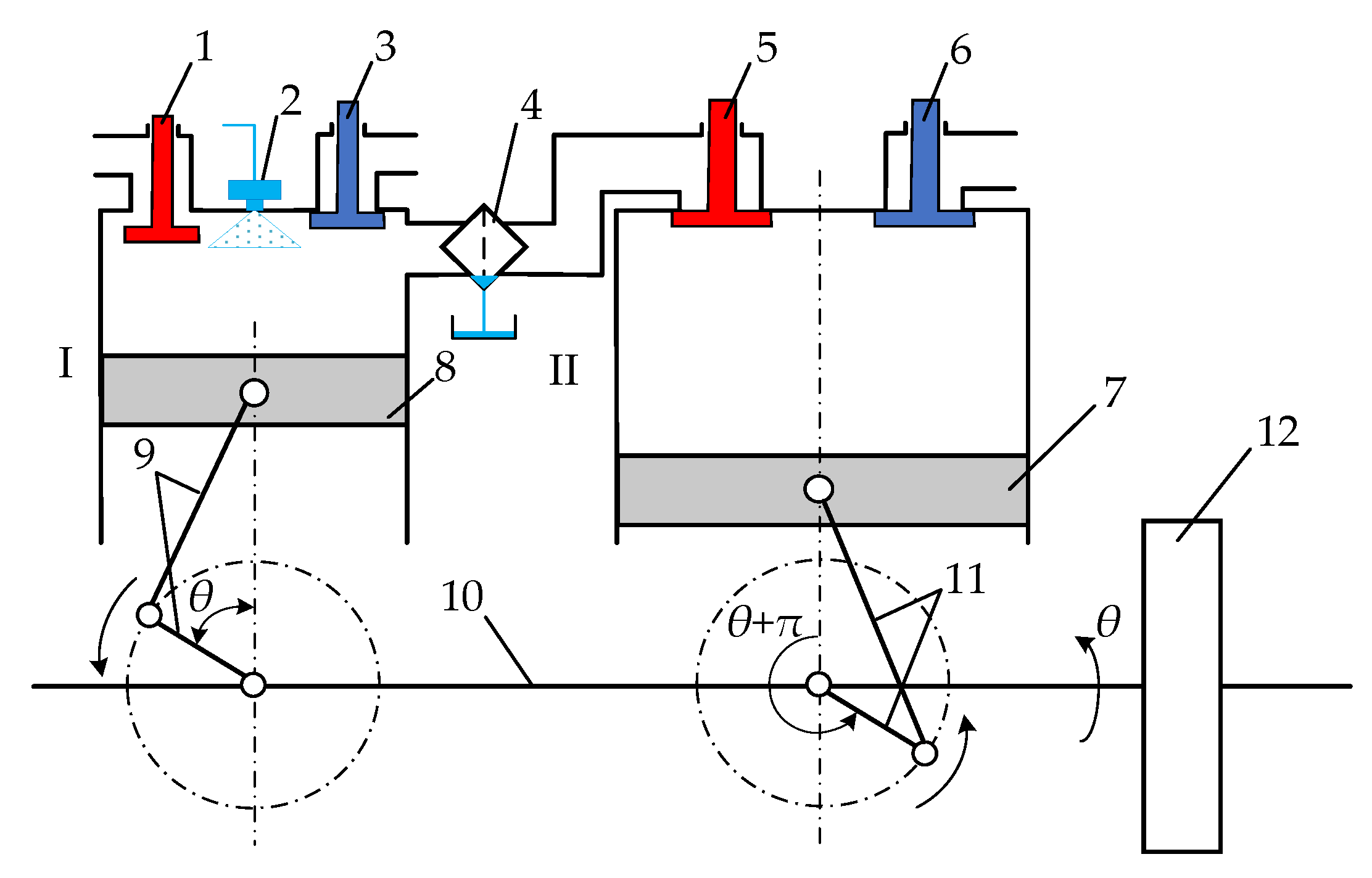
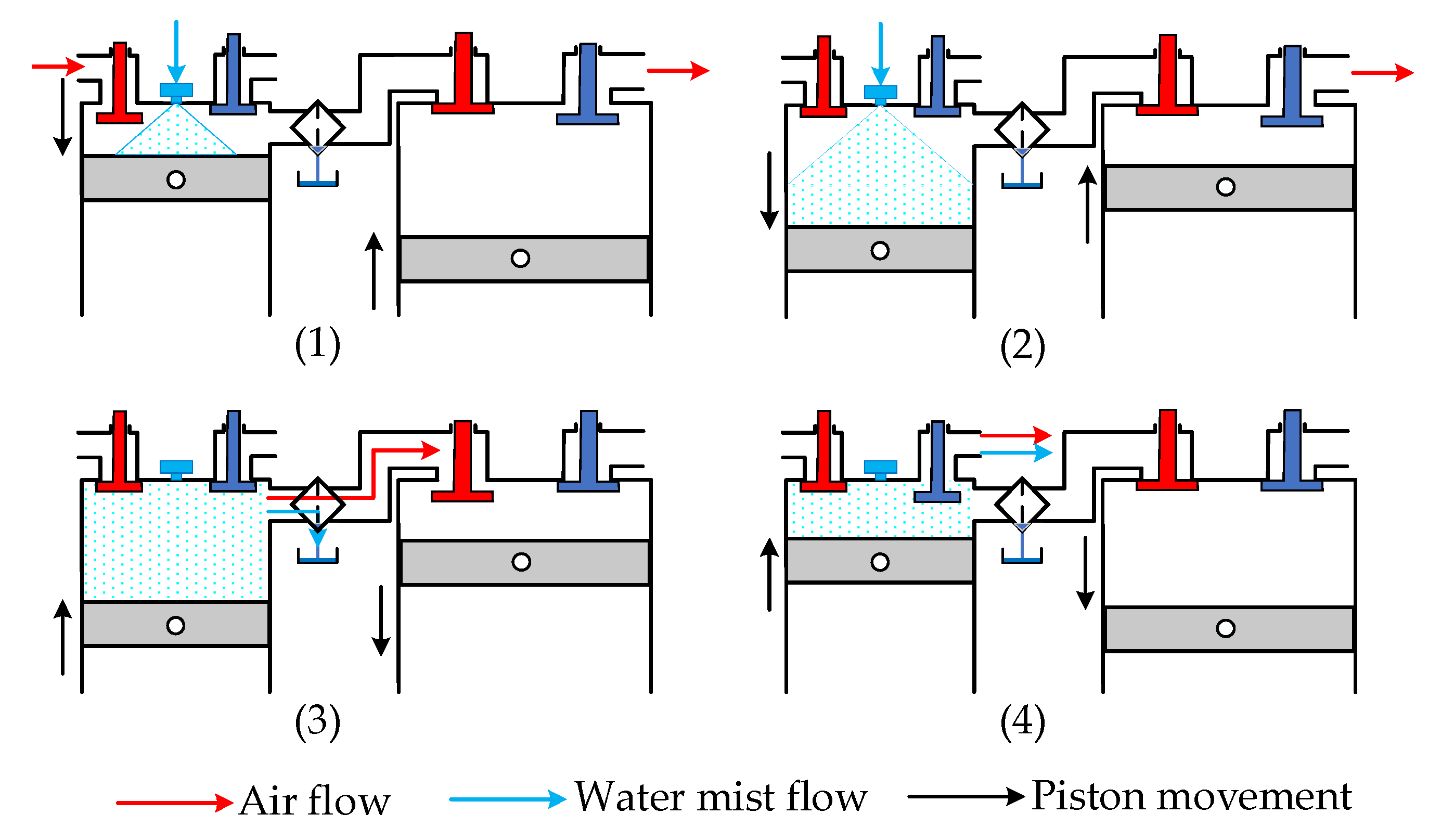
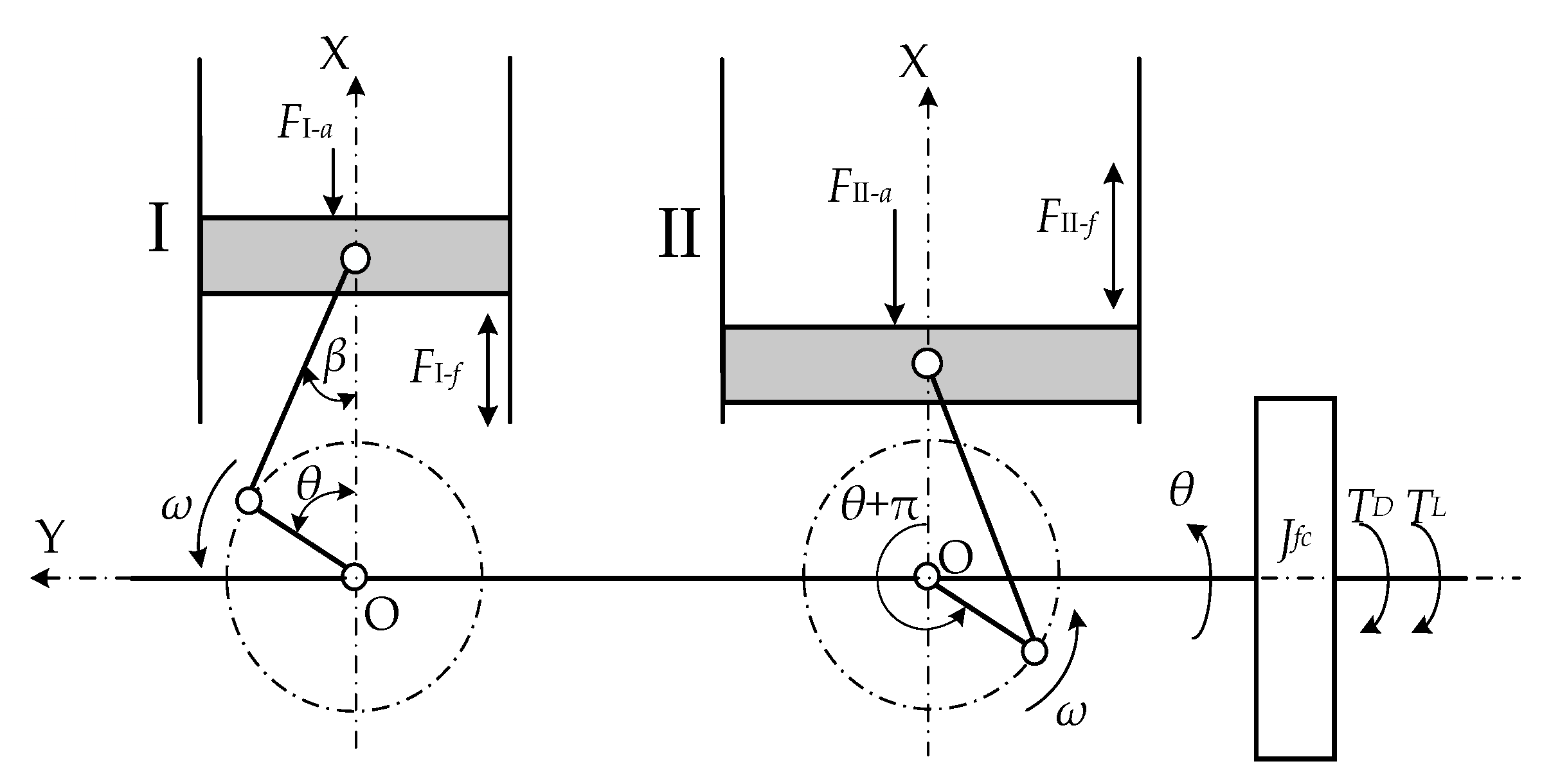

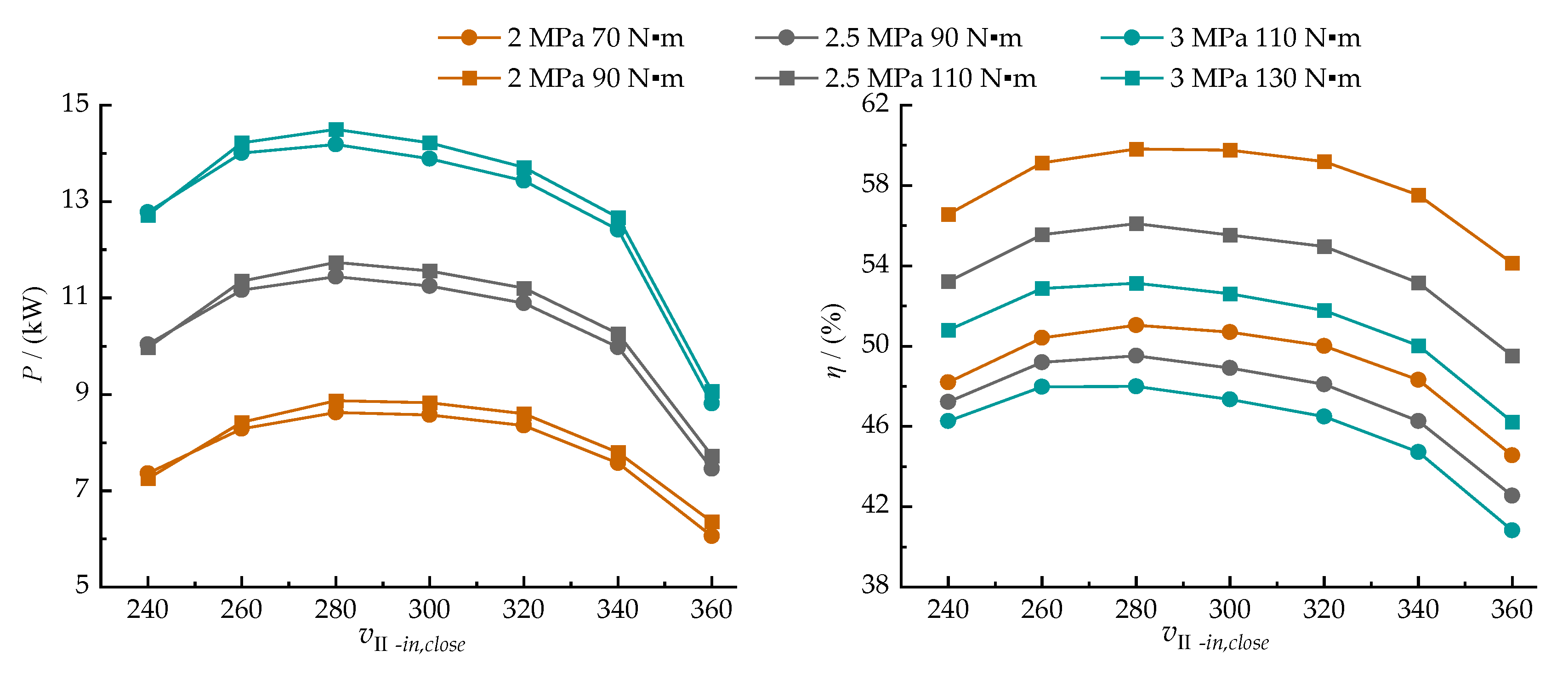
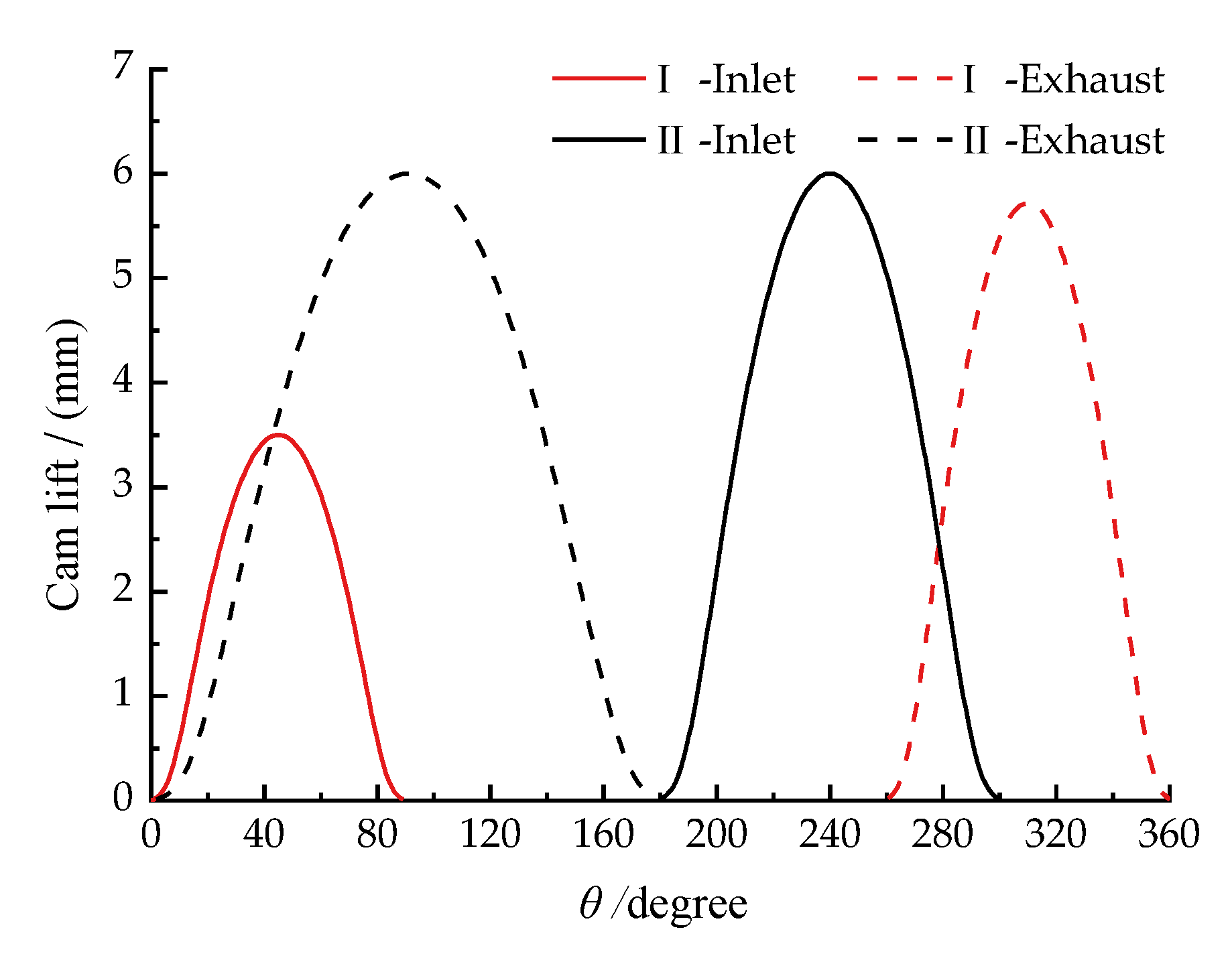

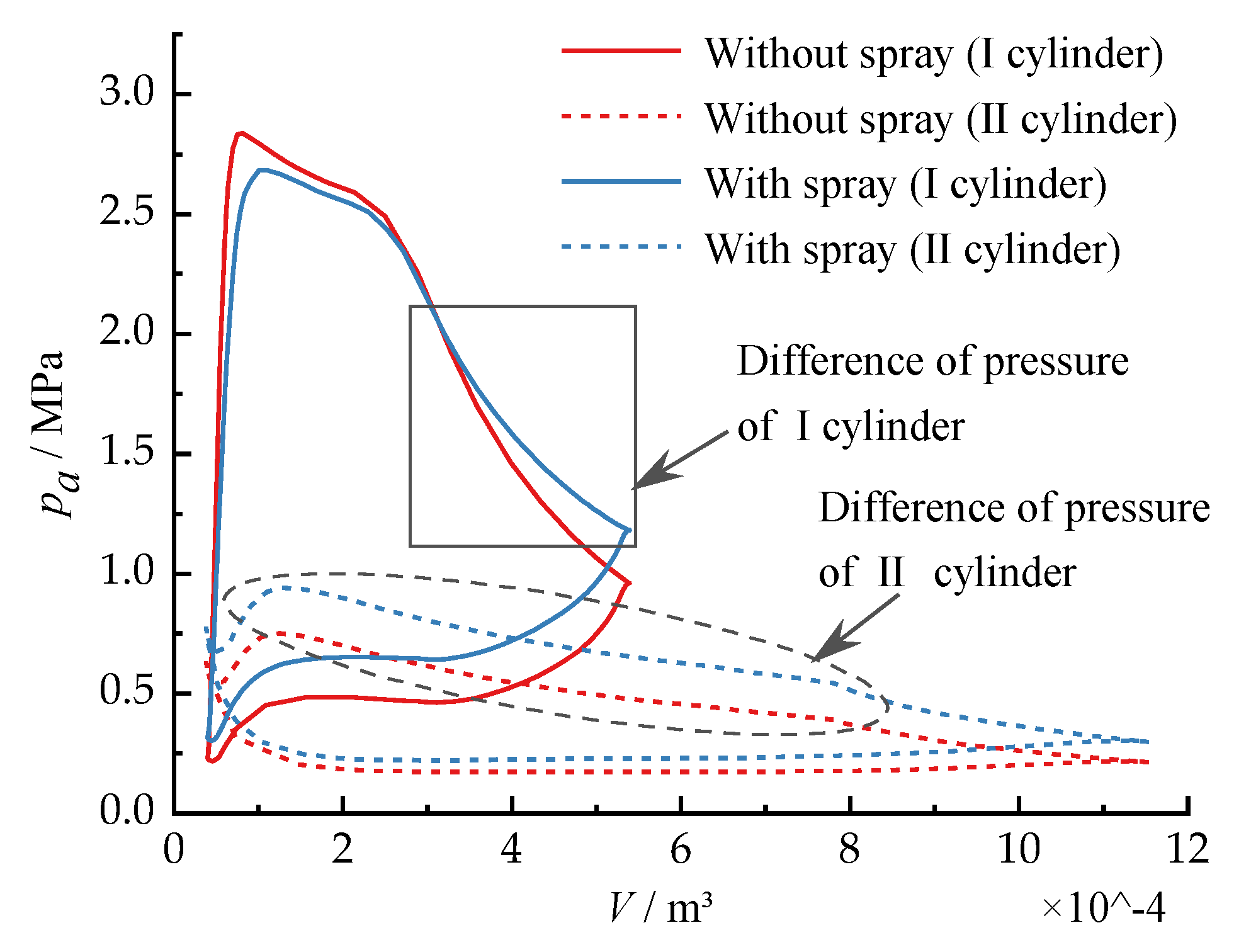



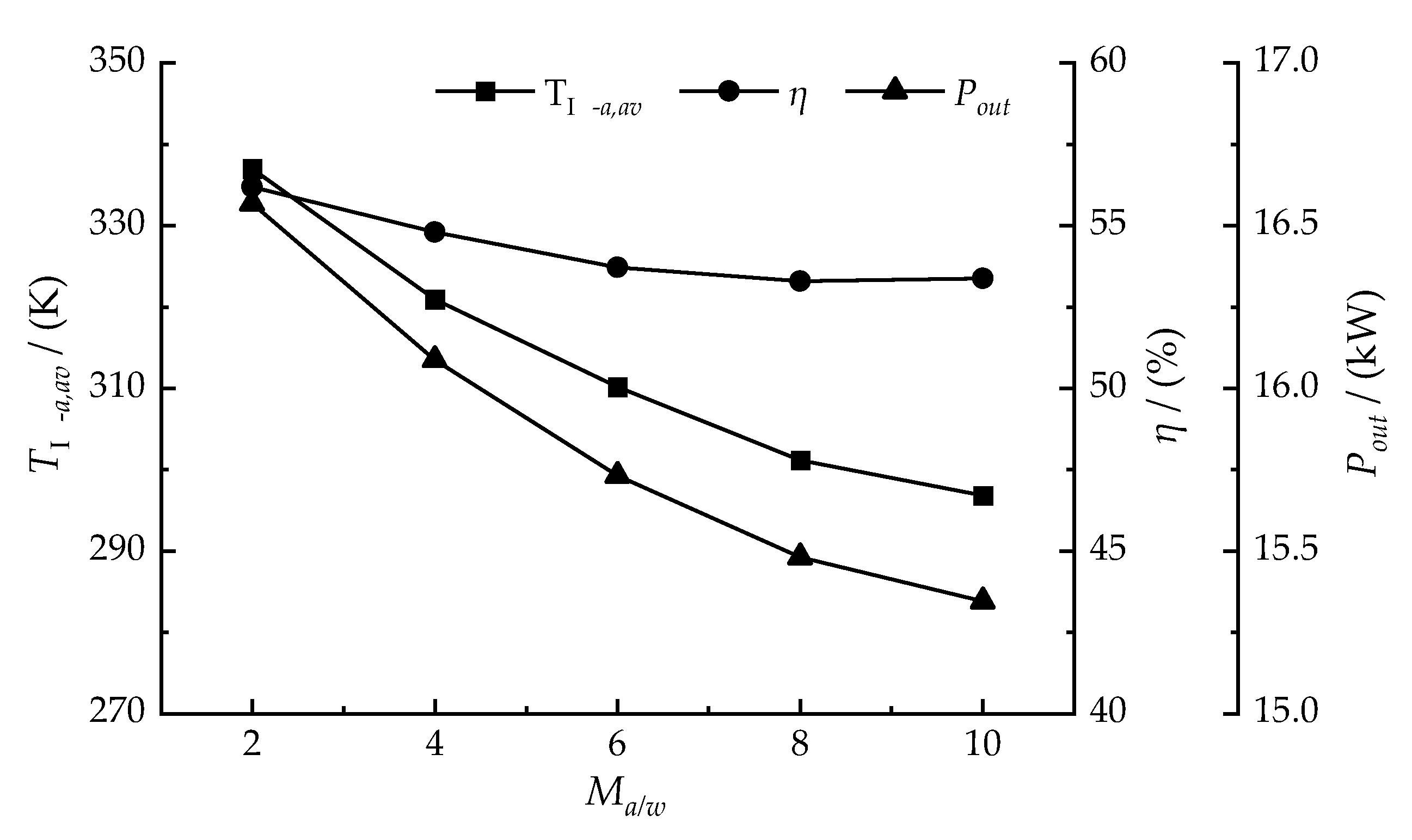
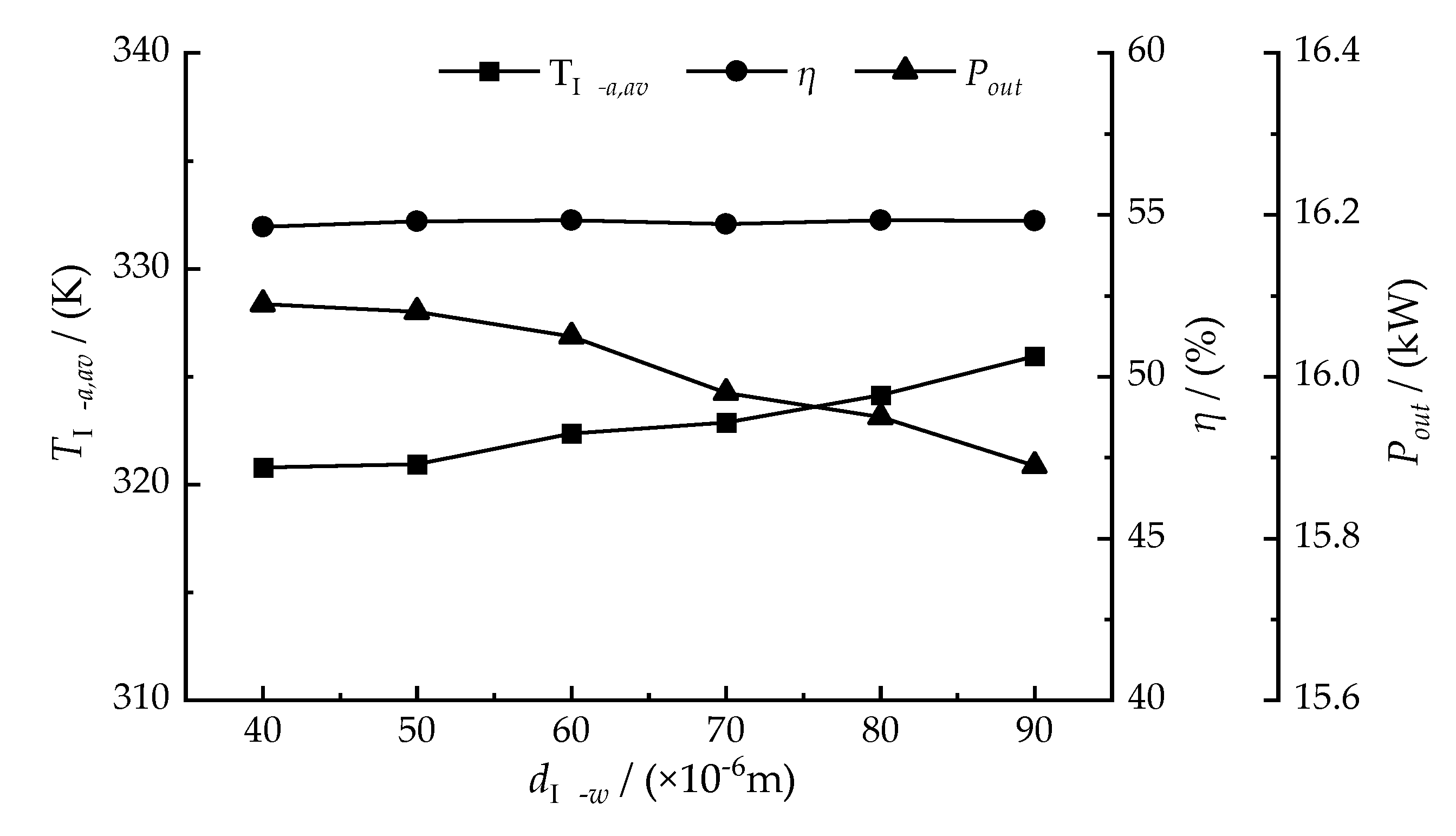
| Parameter | Value | Parameter | Value |
|---|---|---|---|
| I-stage cylinder diameter | 85 mm | II-stage cylinder diameter | 127 mm |
| I-stage inlet and exhaust channel diameter | 12 mm | II-stage inlet and exhaust channel diameter | 18 mm |
| I-stage inlet and exhaust valve stem diameter | 7 mm | II-stage inlet and exhaust valve stem diameter | 7 mm |
| I-stage intake valve lift | 3.5 mm | II-stage intake valve lift | 6 mm |
| I-stage exhaust valve lift | 5.72 mm | The valve cone angle | 45° |
| I-stage inlet opening and closing angle | 0–90° | II-stage exhaust opening and closing angle | 0–180° |
| Radius of the crankshaft | 44 mm | Connecting rod mass | 0.526 kg |
| Connecting rod length | 139 mm | Piston mass | 1.011 kg |
| Damping coefficient | 0.145 | Piston ring friction coefficient | 0.05 |
| Moment of inertia of flywheel and crankshaft | 0.43 kg·m2 | Inlet air temperature | 343 K |
| Atmospheric temperature | 293 K | Atmospheric pressure | 0.1013 MPa |
| Parameter | The NT-TSPE without Spray | The NT-TSPE with Spray |
|---|---|---|
| GI-a,in | 3 MPa | |
| TI-a,in | 343 K | |
| TL | 150 N·m | |
| GI-w,in | - | 0.06 kg/s |
| dI-w | - | 5 × 10−5 m |
| TI-w,in | - | 373 K |
Publisher’s Note: MDPI stays neutral with regard to jurisdictional claims in published maps and institutional affiliations. |
© 2022 by the authors. Licensee MDPI, Basel, Switzerland. This article is an open access article distributed under the terms and conditions of the Creative Commons Attribution (CC BY) license (https://creativecommons.org/licenses/by/4.0/).
Share and Cite
Yu, Q.; Li, X.; Wei, Z.; Sun, G.; Tan, X. Study on Performance of a Modified Two-Stage Piston Expander Based on Spray Heat Transfer. Sustainability 2022, 14, 12764. https://doi.org/10.3390/su141912764
Yu Q, Li X, Wei Z, Sun G, Tan X. Study on Performance of a Modified Two-Stage Piston Expander Based on Spray Heat Transfer. Sustainability. 2022; 14(19):12764. https://doi.org/10.3390/su141912764
Chicago/Turabian StyleYu, Qihui, Xiaodong Li, Zhigang Wei, Guoxin Sun, and Xin Tan. 2022. "Study on Performance of a Modified Two-Stage Piston Expander Based on Spray Heat Transfer" Sustainability 14, no. 19: 12764. https://doi.org/10.3390/su141912764




